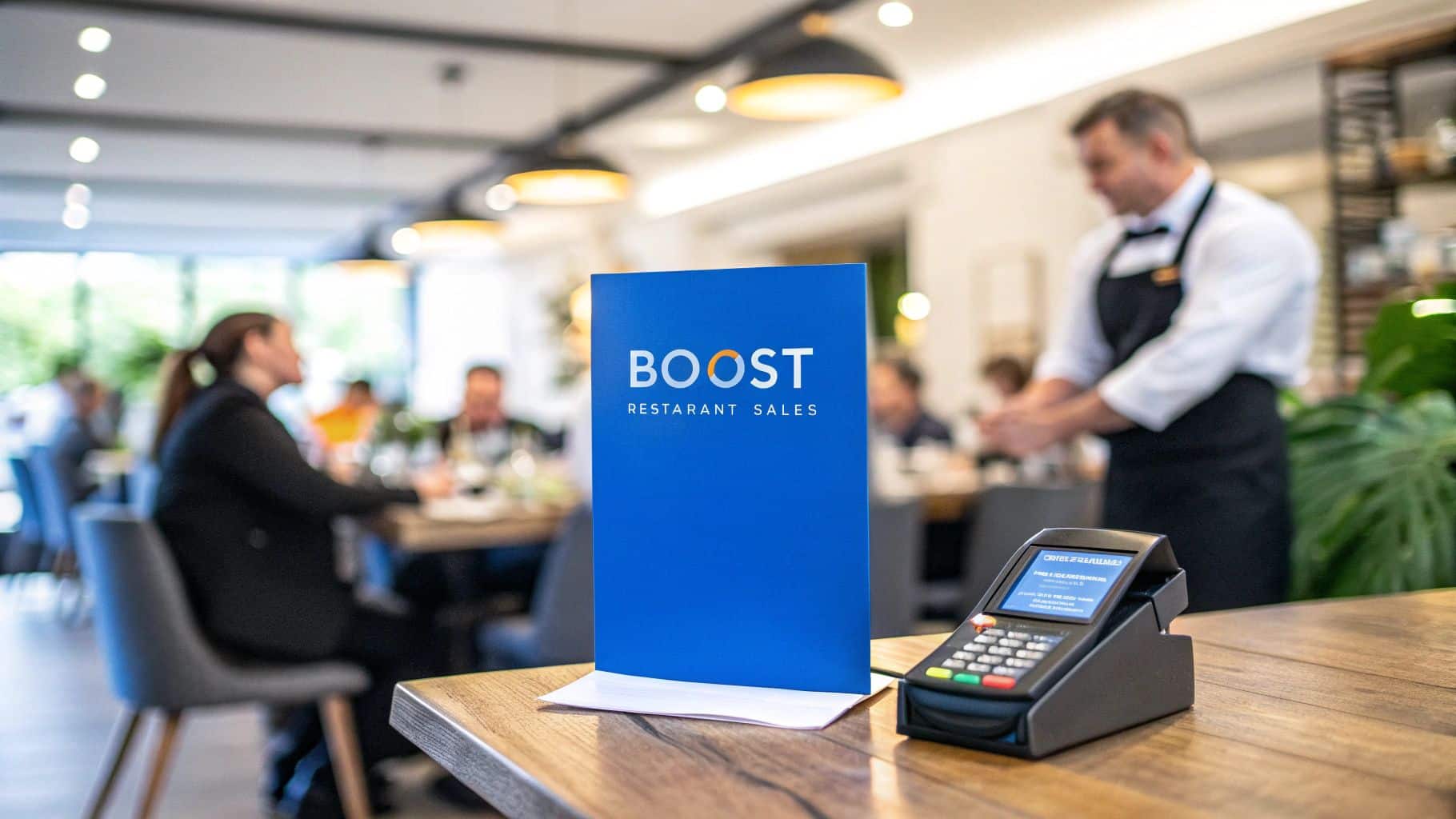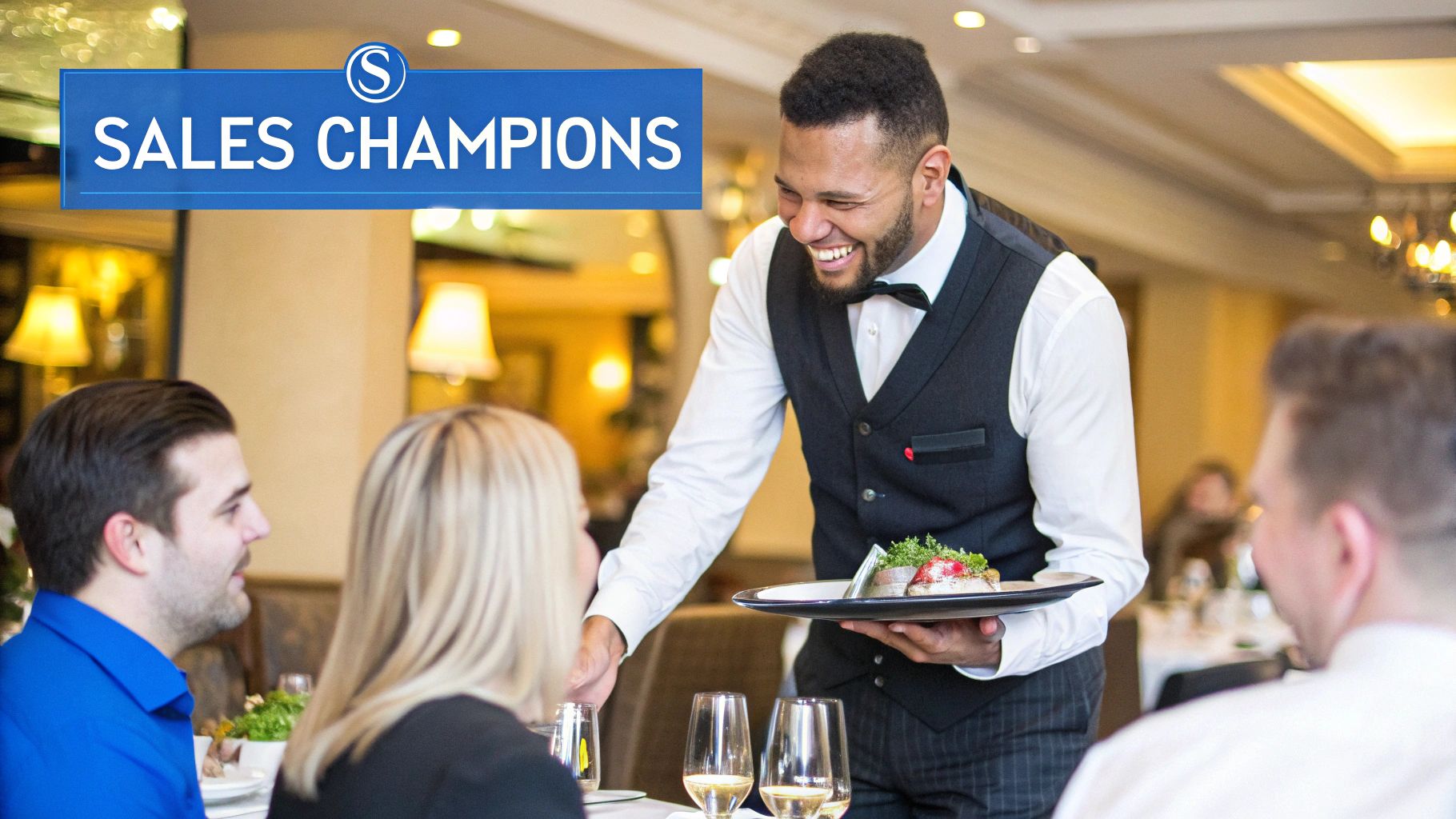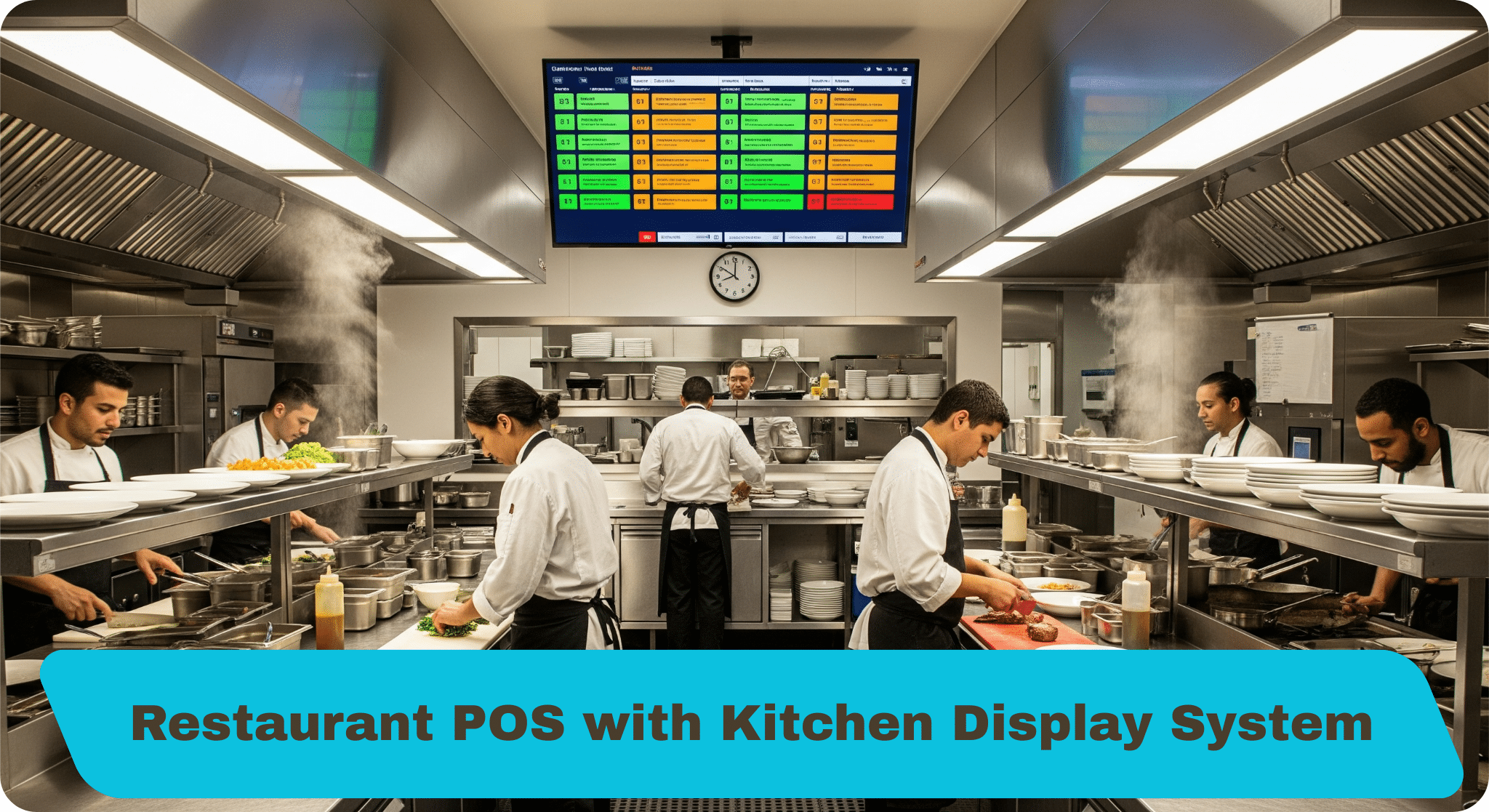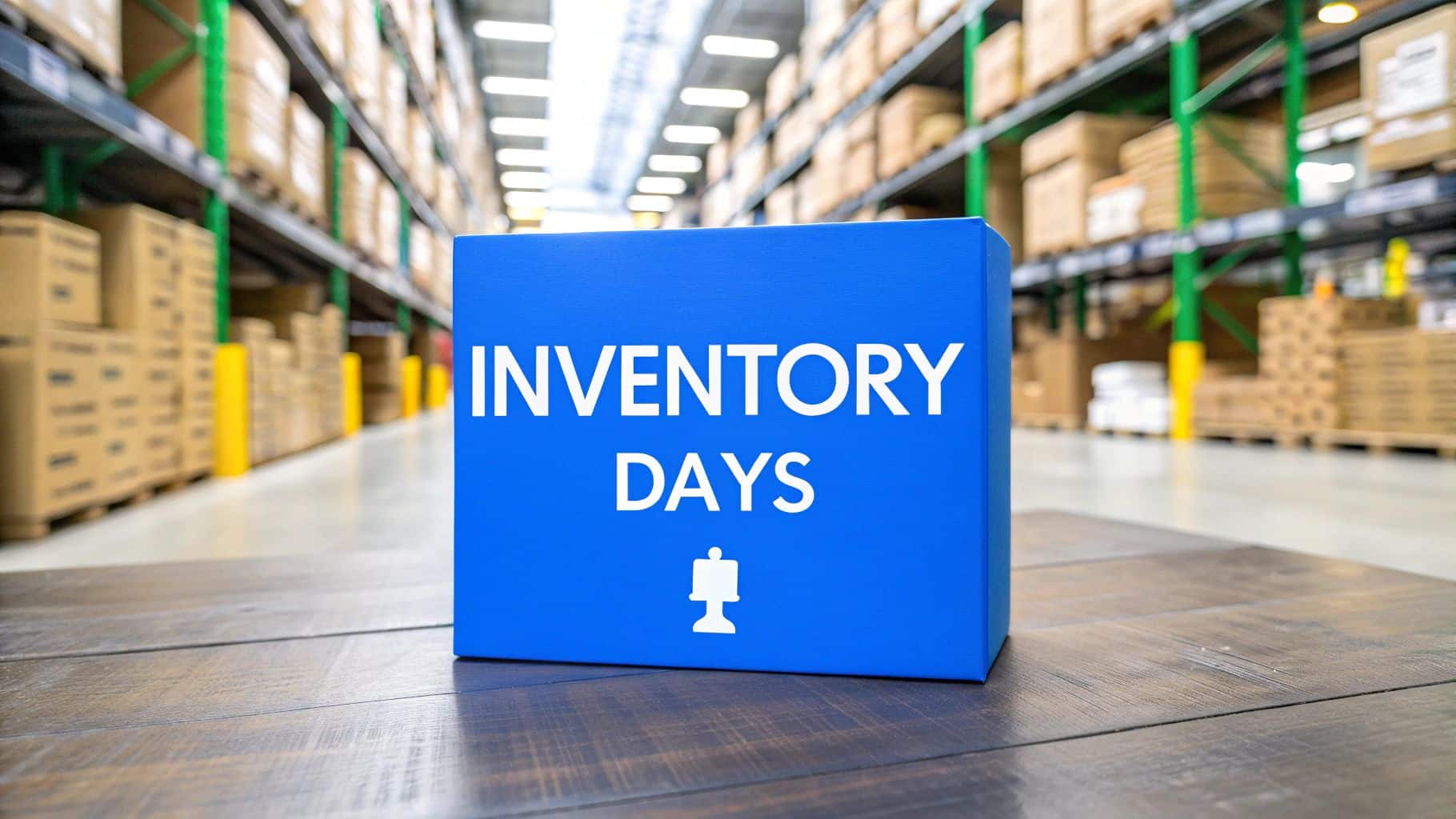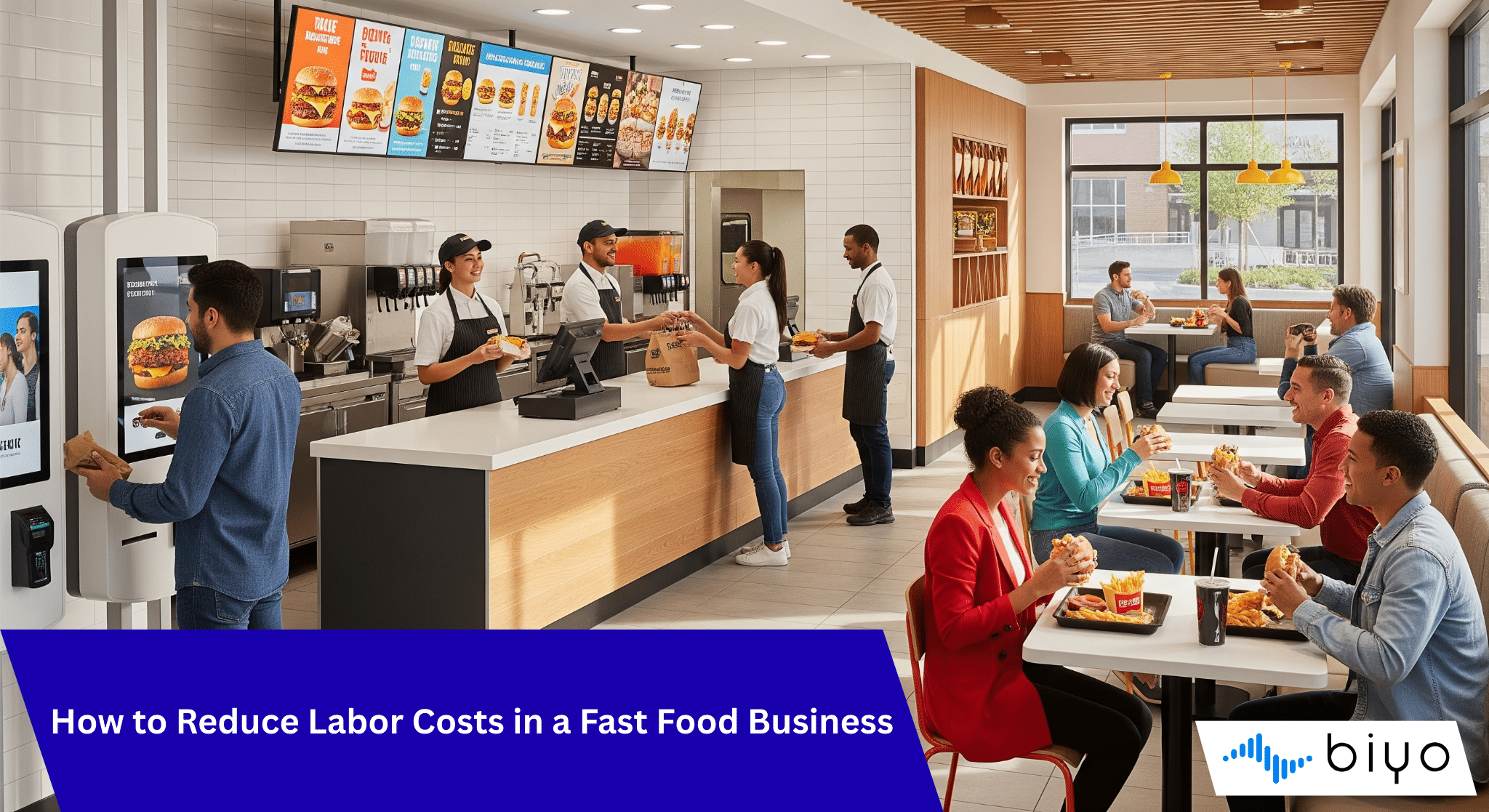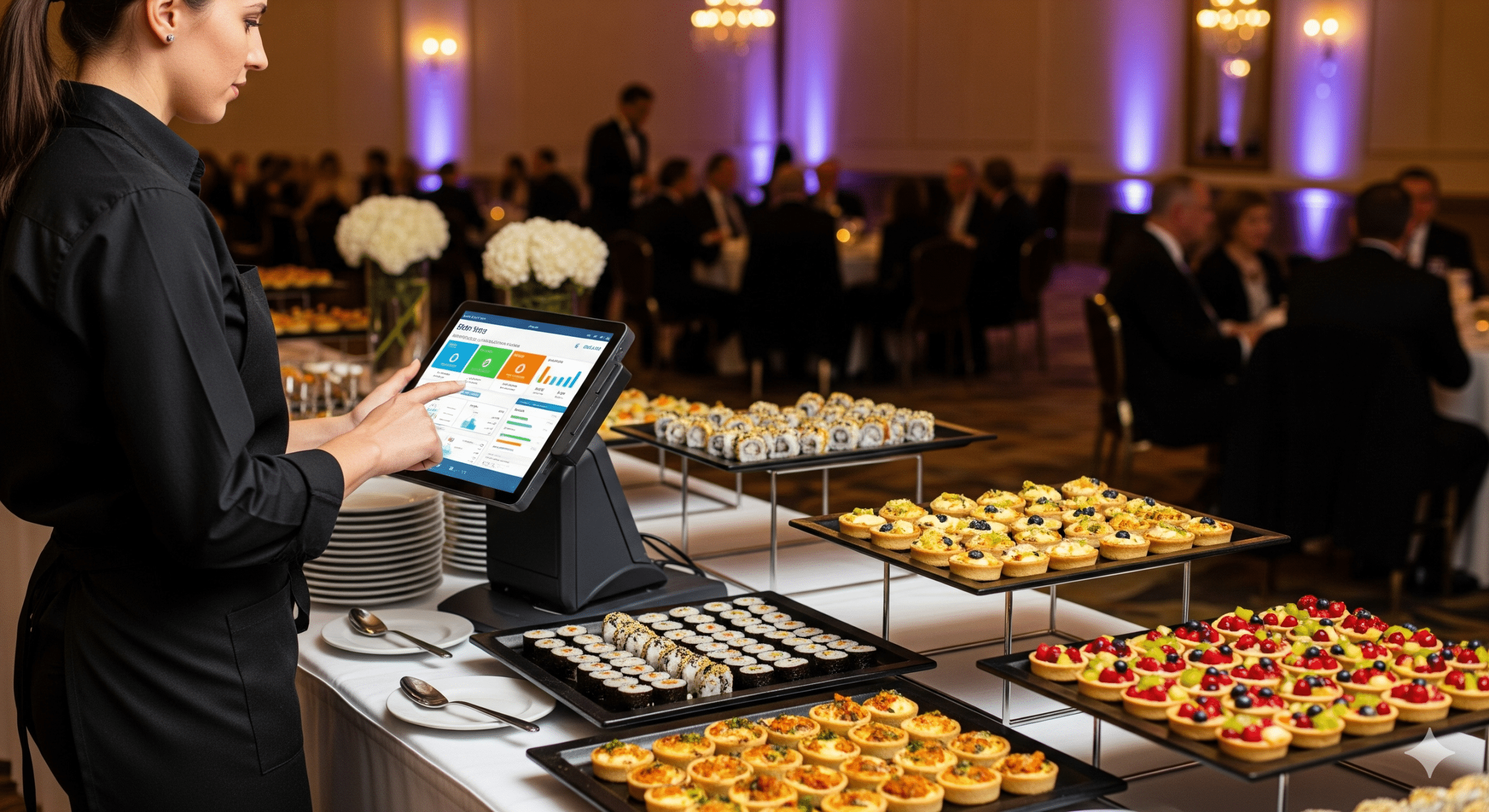Feeling the squeeze from a tough market and rising costs? It's a story I hear all the time. The real secret to boosting restaurant sales isn't some magic bullet; it's a smart, layered approach that weaves together menu psychology, modern tech, stellar service, and marketing that builds loyalty. Forget the quick fixes. To build a business that lasts, you need a solid strategy that can handle challenges like inflation and staff shortages head-on.
Your Blueprint for Lasting Revenue Growth
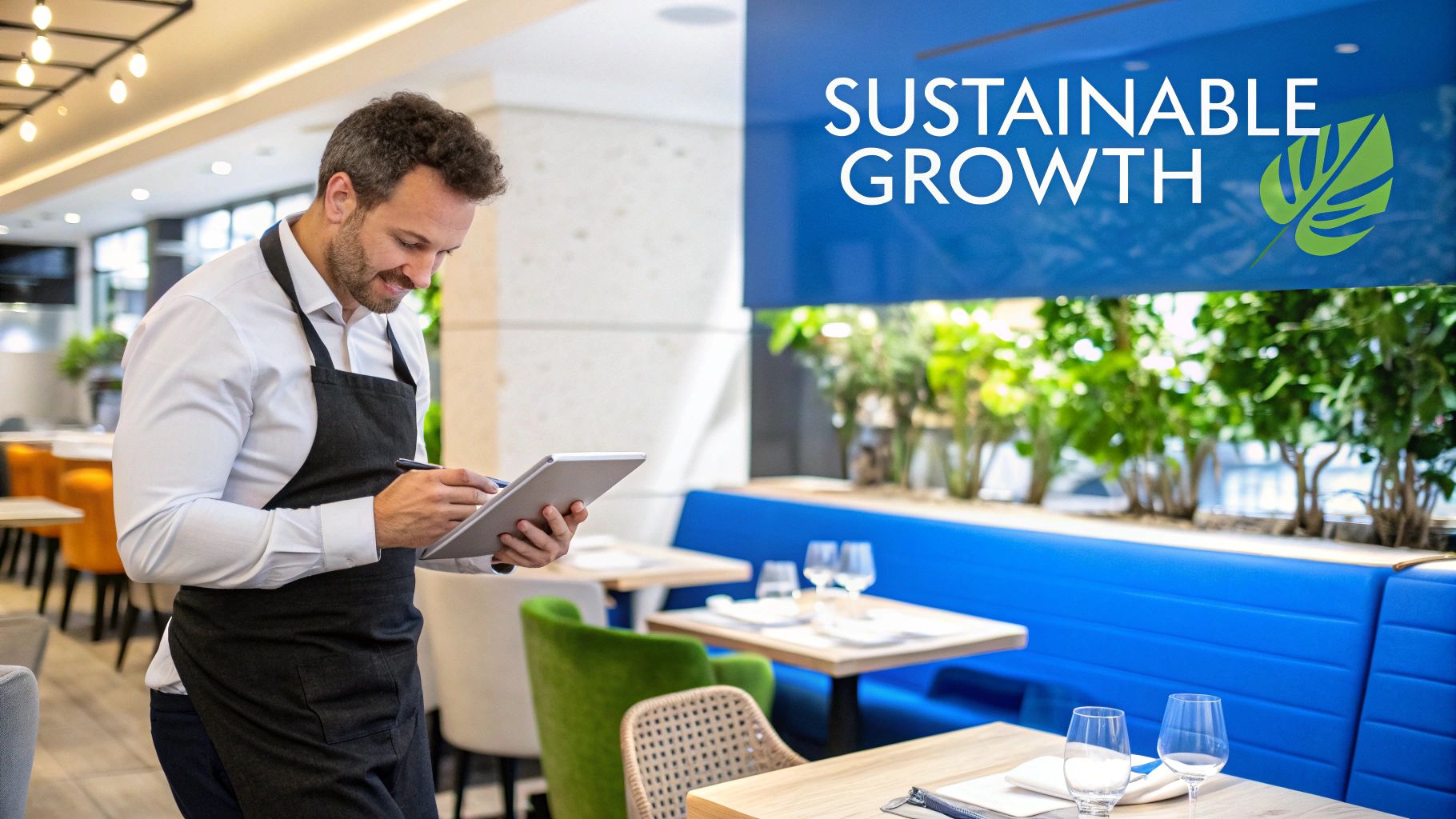
That pressure to grow the bottom line is something every restaurant owner knows well. But we're not just aiming for a temporary spike in sales. The real goal is to build a durable plan for sustainable growth. This guide lays out a practical framework to move you beyond short-term tactics and create a roadmap for long-term success.
We're going to zero in on the core pillars that hold up any successful modern restaurant. When you get these right, you create a business that doesn't just survive but actually thrives, even when the economy gets rocky.
The Cornerstones of Restaurant Growth
To really get a handle on increasing sales, you have to understand the key pieces that drive success. Think of these as the foundation of your entire revenue strategy.
- Menu Psychology and Engineering: Your menu is not just a list of what you sell—it's your most powerful sales tool, period. We’ll get into how to dig into your sales data to make your most profitable dishes the stars of the show.
- Smart Technology Adoption: From your POS system to online ordering, tech isn't a luxury anymore; it's a necessity. The right tools can smooth out operations, boost efficiency, and even unlock entirely new ways to make money.
- Exceptional Service and Staff Empowerment: Your team is the human face of your brand. When you give them the right training and tools, you turn every single customer interaction into a chance to grow your sales.
- Loyalty-Driven Marketing: It costs a whole lot more to find a new customer than to keep an existing one happy. Building a base of loyal regulars gives you a reliable, predictable stream of income you can count on.
The best strategies aren't just a handful of separate tactics; they're an interconnected system. When you make your menu more profitable, you free up cash to invest in better tech. That tech then helps your staff provide better service, which in turn builds the loyalty that keeps people coming back.
Weaving in Digital Tools the Right Way
Putting technology to work effectively is a massive part of growing today. For restaurants ready to integrate digital tools across their business, it pays to develop a robust QR code business strategy. This can streamline everything from ordering and payments to marketing, all of which leads to a better guest experience and a healthier bottom line.
In the sections that follow, we'll dive deep into each of these pillars, with actionable advice and real-world examples to help you build a resilient and profitable restaurant.
Transform Your Menu into a Profit Engine
Your menu is so much more than a list of food. When you get right down to it, it’s the most powerful sales tool you have. A strategically designed menu can subtly guide customers toward your most profitable dishes, boosting your average ticket size without your staff ever having to say a word.
This whole process is called menu engineering, and it's both an art and a science. It's about digging into your own data to turn that piece of paper into a revenue-generating machine.
First things first, you have to know what's actually making you money. This means getting into your sales data to categorize every single item on your menu by two things: how popular it is (how many you sell) and how profitable it is (your margin on each sale). This simple exercise will completely change how you look at your offerings.
You'll quickly find your dishes fall into one of four buckets:
- Stars: These are your champions—highly popular and highly profitable. Customers already love them, and they make you great money.
- Puzzles: These are high-profit but low-popularity items. They're hidden gems just waiting to be discovered. If you can figure out why they aren't selling, they could become your next Stars.
- Plowhorses: Everyone orders these, but they aren't very profitable. They keep the kitchen busy but don't do much for your bottom line.
- Dogs: Low popularity and low profitability. These items are just taking up valuable real estate on your menu and in your walk-in.
This infographic breaks down the core ideas of menu optimization, a process every operator should be doing to boost sales.
Once you've sorted your dishes this way, you'll have a clear roadmap for making your entire menu work harder for you.
Putting Your Menu Data into Action
Okay, so you've identified your Stars, Puzzles, Plowhorses, and Dogs. Now the real work begins. Your mission is to feature your Stars, solve your Puzzles, fix your Plowhorses, and get rid of your Dogs. This is where smart design and a little menu psychology come into play.
Your Stars need to be front and center. Make them impossible to miss. Place them in the upper-right corner of the menu—it's the first place a diner's eyes naturally go. Draw even more attention by putting a box around the item, using a slightly bolder font, or adding a small icon.
Your Puzzles are where you can get creative. These high-margin dishes aren't moving, and you need to figure out why. Is the name boring? Is the description unclear? Try changing "Pan-Seared Branzino" to something more enticing like "Mediterranean Sea Bass with a Zesty Lemon-Caper Sauce." Sometimes, all it takes is a better description or a quick recommendation from a server to turn a Puzzle into a Star.
Don't underestimate the power of words. One study found that simply using more descriptive menu labels increased sales by 27% and made customers feel better about both the food and the restaurant itself.
Plowhorses require a bit more finesse. They're already popular, so you definitely don't want to get rid of them. The trick is to find ways to make them more profitable. Could you tweak the portion size just a little without anyone noticing? Or maybe pair it with a higher-margin side dish by default?
And finally, be ruthless with your Dogs. If an item isn't selling and isn't making you money, it's dead weight. Cut it. Removing it simplifies your menu, shrinks your inventory, and opens up a spot for a potential new Star.
Designing for Dollars
Beyond which items go where, the overall design of your menu has a huge impact on how guests spend. A few simple tweaks can lead to surprisingly big results.
- Ditch the Dollar Signs: Believe it or not, studies show that removing currency symbols ($) encourages people to spend more. It takes the focus off the price. Just listing a price as "24" instead of "$24.00" can make a real difference.
- Invest in Good Photos: A mouth-watering photo can make a dish completely irresistible. If you're going to use images, they have to be professional. Learn the basics of Mastering Food Photography and Lighting to make your most profitable items look as incredible as they taste.
- Balance Deals and Splurges: Diners are feeling the pinch, but they also want to treat themselves. Data shows that searches for meal deals are on the rise, but at the same time, interest in sweet treats is also growing. This tells us you need to offer both value and opportunities for indulgence.
By treating your menu as a living, strategic document—not just a static list—you can directly influence what your customers order and build a more profitable restaurant.
7. Turn Technology Into Your Smartest Sales Partner
In the controlled chaos of a busy restaurant, the right tech stack isn't just a nice perk—it’s the central nervous system of your entire operation. A modern Point of Sale (POS) system has moved far beyond being a digital cash register. Today, it’s the key to making smarter, data-backed decisions that show up directly on your bottom line.
Think of your POS as your in-house business analyst. It's quietly gathering crucial intel on what's selling, when it's selling, and who's buying it. This data is a goldmine.
When you really dig into it, you can spot sales patterns, pinpoint your true peak hours (which might not be when you think!), and even see which servers are masters of the upsell. This is how you move from guessing to knowing, making confident choices about staffing, promotions, and menu changes that actually work.
Your POS Data is Full of Answers
Your POS system holds the keys to some of your biggest questions, but the raw numbers alone won’t do you much good. The real trick is turning that data into concrete actions that make you more money.
Start by pulling regular sales reports to find your "stars"—the dishes people can't get enough of. Just as important, identify the duds that are just taking up space on the menu. This simple audit, which ties right back into menu engineering, helps you sharpen your offerings and focus your purchasing power where it counts.
This mindset goes beyond the food, too. Track individual server performance to see who consistently sells more high-margin extras like appetizers, desserts, or craft cocktails. This isn’t about playing favorites; it's about spotting your top talent and identifying who might need a little extra coaching. It’s a fantastic way to build a stronger, more motivated team.
Get Smart About Online Ordering and Delivery
Let's face it, off-premise dining is here to stay. Winning in this space is non-negotiable for growth, but it brings its own headache: those brutal third-party commission fees.
The smart play is a two-pronged strategy. Use platforms like DoorDash or Uber Eats as what they are: powerful customer acquisition tools. They get your name in front of people who've never heard of you.
But your endgame is always to bring those customers into your own ecosystem. Every single delivery order should include a small flyer or card with an irresistible offer, like 15% off their first order placed directly through your website. It’s a simple, low-cost move that can drastically reduce commission fees over the long haul.
The data backs this up. A recent KPMG report on 2025 restaurant trends shows that restaurants embracing digital channels, including third-party delivery, are seeing significant revenue bumps. The pandemic just sped up the inevitable, making online ordering a fundamental part of the business. You can check out the full KPMG report here.
The impact of integrating new technology into a restaurant's workflow is undeniable. The right tools don't just add convenience; they create efficiencies that directly translate into higher sales and better margins.
Table: Technology Impact on Restaurant Sales
This table illustrates the direct impact of adopting specific technologies on key restaurant performance metrics and sales.
| Technology Solution | Primary Benefit | Impact on Sales |
|---|---|---|
| Modern POS System | Data analysis & sales tracking | Enables menu engineering & targeted promotions, boosting profit margins by 5-10%. |
| Online Ordering Platform | Expands customer reach | Increases order volume, potentially adding 15-30% to overall revenue. |
| Kitchen Display System (KDS) | Faster order fulfillment | Improves table turnover rates, allowing for more seatings per shift. |
| Inventory Management Software | Reduces food waste & stockouts | Protects profit margins by minimizing waste and ensuring popular items are always available. |
As the table shows, each piece of technology addresses a specific operational challenge, converting a solution into a measurable financial gain.
Automate the Grind, Elevate the Experience
So, how do you handle more business without burning out your crew? Smart automation is the answer. The right tech can take over the repetitive, soul-crushing tasks, freeing up your staff to do what they do best: create an amazing guest experience.
A Kitchen Display System (KDS) is a prime example. It zaps orders straight from the POS to the line, killing the need for paper tickets. This means fewer mistakes and faster ticket times. A smooth, efficient kitchen leads to faster table turnover and happier guests—the kind who come back.
Inventory management software is another lifesaver. Instead of manual counts, these systems track stock in real-time, ping you when you're running low on key ingredients, and can even automate purchase orders. This helps you dodge the financial hit of running out of a bestseller and cuts down on the food waste that eats away at your profits.
The point of technology isn’t to replace the human element of hospitality—it’s to amplify it. When the backend runs like a well-oiled machine, your team has the space and energy to create those memorable moments that turn a first-time guest into a lifelong fan.
For a deeper dive into how these tools work together, our guide on how restaurant technology is transforming the foodservice industry is a great next step. Making tech a core part of your strategy is one of the most reliable paths to sustainable growth.
Empower Your Staff to Become Sales Champions
Sure, menu engineering and slick technology can move the needle, but don't ever forget your single greatest sales asset: your front-of-house team. They are the face of your brand, the human connection that technology can't replicate. Every single guest interaction is a chance to boost your bottom line.
Turning your staff into sales champions isn't about teaching them to be pushy. It's about empowering them to be confident, knowledgeable guides who genuinely improve the dining experience. When a server is truly excited about the menu and can make recommendations with conviction, that passion is contagious. It turns a simple transaction into a memorable meal, and that’s how you really increase sales in a restaurant.
Beyond the Basics of Service
Great service should be the bare minimum. What you're aiming for is exceptional service that actively drives revenue. This starts with moving beyond just memorizing the menu to truly understanding it.
A server who has actually tasted the signature cocktail, knows the story behind the chef's special, and can describe the chocolate lava cake with mouth-watering detail is infinitely more persuasive than someone just reading off a list of ingredients. Deep product knowledge is the foundation for any effective upselling.
The best upsell never feels like a sales pitch. It feels like a thoughtful suggestion that elevates the guest's meal, solving a problem they didn't even know they had—like finding the perfect wine pairing for their steak.
Train for Confident Upselling and Cross-Selling
This is where you turn all that potential into real profit. Your training needs to equip the team with specific phrases and techniques that feel natural, not scripted. Ditch the generic, "Would you like an appetizer?" and instead teach them to make a specific, enticing suggestion based on the conversation and context.
Here are a few practical examples to get you started:
- The Specific Suggestion: Instead of, "Can I get you a drink?" try, "Our new seasonal margarita has been a huge hit tonight. It has a hint of spiced pear that goes beautifully with our fresh guacamole."
- The Guided Add-On: When a guest orders a salad, the server can ask, "That's a great choice. Would you like to add our grilled salmon or chicken for a bit more protein? The salmon is fantastic with that dressing."
- The Dessert 'Planting': Early in the meal, a server might casually mention, "Just so you know, our pastry chef only made a limited number of chocolate lava cakes tonight. If you think you might be interested, I can set one aside for you."
These small shifts in language transform a question into an expert recommendation. It makes the guest feel cared for and much more likely to say yes. To build out a solid program, check out our guide on comprehensive training for restaurant staff for more ways to sharpen your team's skills.
A Positive Culture Is a Profitable Culture
High staff turnover is a silent killer of your profits. You see the obvious costs of constantly hiring and training, but the hidden cost is the loss of consistency and expertise that directly tanks the guest experience—and your sales along with it.
Creating a positive work culture where your team feels valued and motivated is non-negotiable for retention. In fact, industry data shows the U.S. restaurant sector is projected to need 15.9 million jobs by 2025, which means the competition for good people is fierce. Cutting down on turnover doesn't just save you money on training; it gives you a seasoned, confident team that delivers superior service. And that is a proven path to higher revenue.
When your team is happy, they become your best brand ambassadors. They're more likely to go the extra mile, more engaged at work, and far more effective at creating those memorable moments that lead to bigger checks and glowing online reviews. That’s what builds a loyal customer base that keeps coming back for more.
Build a Loyalty Loop That Drives Repeat Business
It’s one of the oldest rules in the book, and it's especially true for restaurants: getting a new customer in the door costs a whole lot more than keeping one you already have. When you build a solid base of regulars, you create a stable, predictable stream of revenue that you can count on.
This isn’t about just handing out a punch card. It’s about creating a real connection that makes people feel like they belong, even if it's only their second time visiting. This is how you turn a one-time diner into a fan for life.
A smart loyalty program combined with active online reputation management creates a powerful cycle. Happy customers come back, they spend more, and they tell their friends to do the same. This is a foundational play for anyone serious about figuring out how to increase sales in restaurant operations for the long haul.
Designing a Loyalty Program People Actually Use
Think of a loyalty program as more than just a marketing gimmick. It’s your secret weapon for understanding your guests and personalizing their experience. The whole point is to make them feel seen and appreciated, which in turn boosts how often they visit and how much they spend.
There are a few ways you can structure this, each with its own vibe:
- Points-Based Systems: The classic approach. Customers earn points for every dollar spent, which they can cash in for rewards like a free appetizer or a discount. It's simple, clean, and everyone gets it right away.
- Tiered Rewards: This model adds a bit of a game to the experience. As guests spend more, they unlock better perks and climb the ranks. A "Silver" member might get a free birthday dessert, but a "Gold" member gets that plus first dibs on new menu items.
- Exclusive Perks: Instead of points, this is about immediate value. Members might get a free coffee with any purchase or access to a "secret" off-menu item. This creates an insider feeling that can be a huge motivator.
A loyalty program isn't just about giving away free stuff. It’s a data-gathering engine. Ethically collecting information like visit frequency, favorite dishes, and birth dates allows you to send targeted, personalized offers that feel like a special treat, not spam.
Imagine sending a quick email to a guest who you know loves your spicy rigatoni, just to let them know it's back as a weekly special. That's the kind of personal touch that builds a genuine connection and keeps people coming back.
Turn Online Reviews into a Marketing Asset
Your online reputation on sites like Google and Yelp is basically your digital front door. It’s where countless potential customers decide whether to give you a shot. Simply ignoring these platforms is not an option—you have to be in the game, actively managing your presence.
Responding to reviews, both the good and the bad, is absolutely critical. A thoughtful, calm response to a negative review can sometimes do more for your reputation than a dozen five-star ratings. It shows you're listening, you care, and you’re committed to making things right. This not only gives you a chance to win back an unhappy customer but also proves your professionalism to everyone else reading.
For instance, a simple reply like, "We're so sorry to hear your steak was overcooked. That's not our standard, and we'd love the chance to make it right for you," can completely defuse a bad situation.
On the flip side, engaging with positive reviews helps build a sense of community. A quick, "Thanks so much for the kind words! We're thrilled you enjoyed the scallops and can't wait to see you again," makes your happy customers feel heard and reinforces their decision to praise you publicly.
Creating a Community Around Your Brand
At the end of the day, building loyalty is about fostering a community. It's about making people feel like they're part of something. When you pair a great loyalty program with sharp reputation management, you're no longer just selling food; you're building relationships.
Think about hosting exclusive events for your loyalty members, like a private wine tasting or a sneak peek of a new seasonal menu. These are the kinds of experiences that create true brand ambassadors—people who will sing your praises both online and off. A loyal customer base is your single most reliable asset for sustainable growth, turning your restaurant into a place people don't just visit, but actively support.
Got Questions About Boosting Restaurant Sales?
Running a restaurant means you're wearing a dozen different hats at once, and sometimes you just need a straight answer. As you start trying new things to bring in more business, some questions tend to pop up again and again. Here are the answers to the most common ones we hear from restaurant owners.
What's the Fastest Way to See a Bump in Sales?
If you need results now, the best move is a one-two punch: optimize your menu and run a can't-miss promotion. This gets people in the door immediately while you work on your bigger, long-term growth plans.
First, jump into your sales data and find your "star" items—the ones that are both popular and highly profitable. Make them impossible to miss on your menu and get your servers excited about recommending them. You'd be surprised how often a simple "The short rib is incredible tonight" can seal the deal.
At the same time, launch a limited-time offer that creates a little buzz. Think a weekday lunch special, a creative happy hour with unique cocktails, or a two-for-one appetizer deal. Push it hard on social media and through your email list to create a sense of urgency. It’s a great way to get a quick injection of cash.
How Much Should I Actually Be Spending on Marketing?
The old rule of thumb is to set aside 3-6% of your total revenue for marketing. But let's be honest, how you spend that money matters a lot more than the exact percentage. The right strategy really depends on where your restaurant is at in its journey.
If you're brand new, you'll likely spend more on getting your name out there—think local social media ads or paying a few food bloggers to stop by. For a restaurant that's been around a while, that money might be better spent on ads that bring back your regulars or on beefing up your loyalty program.
The most important thing is to track what's working. If you spend $500 on a Facebook ad campaign and it brings in $2,000 in online orders you can track, that's a 4x return. Double down on what works and don't be afraid to pull the plug on channels that just aren't connecting with your customers.
Can Changing My Restaurant's Design Really Increase Sales?
It absolutely can. Think of your restaurant’s atmosphere as your silent salesperson. A well-designed, comfortable space doesn't just look nice—it directly influences how your guests behave and, more importantly, how much they spend.
When people feel comfortable and relaxed, they stick around. They’re far more likely to order that extra round of drinks, split a dessert, or add a coffee at the end of their meal. A smart layout also helps your staff move more efficiently, which means turning tables faster during a busy service without ever making guests feel rushed.
Even small tweaks can make a huge difference:
- Better Lighting: Softer, warmer lighting can make the whole place feel more upscale, easily justifying those premium menu prices.
- Comfortable Seating: If guests aren't comfortable, they're thinking about leaving. Comfy chairs encourage them to settle in.
- Good Acoustics: When you have to shout over the table, the experience suffers. Dialing down the noise makes it easier for people to connect and enjoy themselves.
What Are the Most Important Numbers to Track for Sales Growth?
To really get a handle on your business, you have to look past the top-line revenue number. A handful of Key Performance Indicators (KPIs) tell the real story of what’s happening behind the scenes.
Keeping a close watch on these metrics gives you a clear, actionable snapshot of your restaurant's financial health. It shows you exactly where your strategies are paying off and where they’re falling short.
These are the vital signs for your restaurant:
- Average Check Size: This is the average amount each person or table spends. It's the clearest indicator of how well your upselling and cross-selling efforts are working.
- Table Turnover Rate: This tells you how efficiently you're seating new guests. A faster turn rate during your busiest hours means more money in the bank.
- Customer Lifetime Value (CLV): This is a projection of the total revenue you can expect from a single customer over time. A high CLV is a fantastic sign of customer loyalty.
- Food Cost Percentage: This is your ingredient cost as a percentage of a dish's menu price. Keeping this number under control is absolutely fundamental to your profitability.
Ready to turn these insights into action? The right technology makes all the difference. Biyo POS is an all-in-one system that provides the advanced analytics you need to track KPIs, engineer your menu, and manage your loyalty programs seamlessly. Simplify your operations and start making data-driven decisions that boost your bottom line. Discover how Biyo POS can help your restaurant grow.
